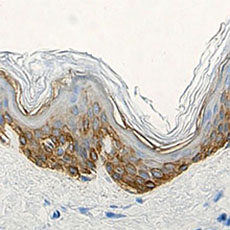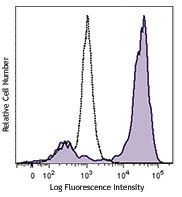- Clone
- Poly19055 (See other available formats)
- Regulatory Status
- RUO
- Other Names
- Keratin, type II cytoskeletal 5, CK-5, 58 kda cytokeratin, type-II keratin Kb5, epidermolysis bullosa simplex 2 Dowling-Meara/Kobner/Weber-Cockayne types, keratin 5 (epidermolysis bullosa simplex, Dowling-Meara/Kobner/Weber-Cockayne types), krt5
- Isotype
- Rabbit Polyclonal
- Ave. Rating
- Submit a Review
- Product Citations
- 25 publications

| Cat # | Size | Price | Quantity Check Availability | Save | ||
|---|---|---|---|---|---|---|
| 905503 | 25 µg | 100€ | ||||
| 905504 | 100 µg | 280€ | ||||
Keratin 5 is a member of the type II (basic or neutral) cytokeratin family. Type II keratins, in general, are heteropolymeric structural proteins coexpressed during differentiation of simple and stratified epithelial tissues. Keratin 5 is specifically expressed in the basal layer of the epidermis along with Keratin 14.
Product DetailsProduct Details
- Verified Reactivity
- Human, Mouse, Rat
- Reported Reactivity
- Dog, Non-Human Primate
- Antibody Type
- Polyclonal
- Host Species
- Rabbit
- Immunogen
- This monospecific polyclonal antibody was raised against a peptide sequence derived from the C-terminus of the mouse keratin 5 protein.
- Formulation
- Phosphate-buffered solution, pH 7.2, containing 0.09% sodium azide.
- Preparation
- The antibody was purified by affinity chromatography.
- Concentration
- 0.5 mg/ml
- Storage & Handling
- The antibody solution should be stored undiluted between 2°C and 8°C.
- Application
-
IHC-P - Quality tested
WB, ICC - Verified - Recommended Usage
-
Each lot of this antibody is quality control tested by formalin-fixed paraffin-embedded immunohistochemical staining. For immunohistochemisty, a concentration range of 0.2 - 5.0 μg/ml is suggested. For Western blotting, a concentration range of 0.5 - 1.0 μg/ml is suggested. For immunocytochemistry, a concentration range of 0.5 - 1.0 μg/ml is recommended. It is recommended that the reagent be titrated for optimal performance for each application.
- Application Notes
-
Predicted MW is ~ 62 kD. This antibody weakly reacts with mouse.
This product may contain other non-IgG subtypes.
- Application References
-
- Hübner A, et al. 2012. Proc. Natl. Acad. Sci. USA 109:12046. (IHC) PubMed
- Kierszenbaum AL, et al. 2003. Mol. Biol. Cell 14(11):4628. (IHC) PubMed
- Hu Y, et al. 2001. Nature 410:710.
- Yuspa SH, et al. 1989. J. Cell Biol. 109:1207.
- Liang Y. 2011. Patholog. Res. Int. 2011:936794. (IHC) PubMed
- Roop DR, et al. 1984. J. Biol. Chem. 259:8037.
- Product Citations
-
- RRID
-
AB_2734679 (BioLegend Cat. No. 905503)
AB_2734679 (BioLegend Cat. No. 905504)
Antigen Details
- Structure
- Keratin 5 is a 62 kD protein.
- Distribution
-
Cytoskeleton, extracellular, and nucleus.
- Function
- Keratin 5 mutations have been associated with a complex of diseases termed epidermolysis bullosa simplex.
- Biology Area
- Cell Biology, Cell Motility/Cytoskeleton/Structure, Neuroscience, Neuroscience Cell Markers
- Molecular Family
- Intermediate Filaments
- Gene ID
- 3852 View all products for this Gene ID
- UniProt
- View information about Keratin 5 on UniProt.org
Related Pages & Pathways
Pages
Related FAQs
Other Formats
View All Keratin 5 Reagents Request Custom Conjugation| Description | Clone | Applications |
|---|---|---|
| Keratin 5 Polyclonal Antibody, Purified | Poly19055 | IHC |
| Purified anti-Keratin 5 | Poly19055 | IHC-P,WB,ICC |
Customers Also Purchased
Compare Data Across All Formats
This data display is provided for general comparisons between formats.
Your actual data may vary due to variations in samples, target cells, instruments and their settings, staining conditions, and other factors.
If you need assistance with selecting the best format contact our expert technical support team.
-
Keratin 5 Polyclonal Antibody, Purified

Anti-K5 antibody (clone Poly19055) showing strong cytoplasmi... 

-
Purified anti-Keratin 5

IHC staining of anti-Keratin 5 antibody (Poly19055) on forma... 
Total lysates (15 µg protein) from A431 (Human, Positive con... 
Immunofluorescence of A431 cells with (A) Rabbit Isotype con... 
IHC staining of Purified anti-Keratin 5 (clone Poly19055) on...


 Login / Register
Login / Register 



















Follow Us